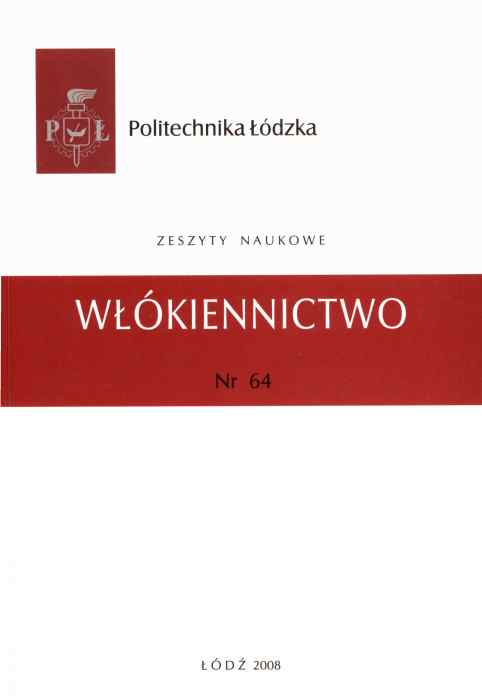Abstract
In order to provide polyester with antibacterial and atrombogenic properties, a two-stage modification of polyester yarn, surgical threads and vascular prothesiswas carried out. Modification was based on introducing macromolecules into the polymer of carboxylic group through grafting them with PAA or PMA - I stage. In the second stage of modification, the grafted products were imbued with biocide solution from amiglicozyde group (Amikacin), which are derivatives of penicillin (Amoxycylline) and silver ions derived from non-organie salts - (each biocide separately).
A method of modification of surgical threads add knitted vascular prothesis was established, where only slight amount of by-product is created, thus the method is virtually waste-free. Throughout the simulation tests, kinetics of biocide release to water and an appropriate buffer or physiological salt from modified products was tested, assuming that any release of the drug under the influence of tissue liquids creates a poss i bili ty of inhibiting the growth of microorganisms, theref ore also creating a possibility of preventing post-operation infections.
During the in vitro tests, antibacterial character of modified products was established against Gram+ and Gram- bacteria, which are typical for the hospital conditions.
There were also some introductory (in vivo) tests of irritating action carried out and additionally, atrombogenic properties of modified fibres were tested. It was stated that surgical PET threads that include antibiotic in their structure are active on a wide scale towards Gram+ and Gram- bacteria.
Antibiotics or Ag+ released from surgical threads are easily absorbed in tissue environment, making the wound heal without exudations or inflammations. There were also the following measurements taken: electrokinetic potential, water permeability and hydrophilic character of the modified fibres of vascular prothesis.
References
Kielar M., Noszczyk W.: Pol. Przegl. Chir., 71, 12, 1274-1284, (1999).
Janczak D., Chudoba P., Polak W., Szyber P.: Chirurgia Naczyniowa, sierpień 2000.
King M. et al.: The Performance of Resorbable Coatings on braided Surgical Sutures, Word Textile Conference 2nd AUTEX Conference, Bruges, Belgium, 1-3 July 2002.
Speller D.C., Humphreys H.: Hospital acquired infection. In Microbiology and Microbial Infections (9th Ed.), Collier A Balows & M Sussman, Eds, Arnold and Oxford University Press, London (1998).
Dutkiewicz J., Rakusa-Szuszczewski S., Raczyński K., Lesiakowska K., Pat. Pol. 148 190 (1990).
Dutkiewicz J., Szosland L., Raczyński K., Lesiakowska K., Rakusa Szuszczewski S.: Pat. Pol. 149 693 (1990).
Dutkiewicz J., Judkiewicz L., Papiewski A., Kucharska M., Ciszewski R.: Some uses of Krill Chitosan as Biomateriał in Chitin and Chitosan, p. 1719, Elsevier Applied Science, London 1989.
Bocheńska J.: Paent. Polski. 179483 (2000).
Bocheńska J.: J.Appl. Polym. Sci., 80, 1914 (2001).
Kabatova V., Spevarova E., Marcincin A.: IV Polish-Slovak Symposium, Łódź, 19-20.03.1998.
Performance Standards for Antimicrobial Susceptibility Testing. Eleventh Information Suplement, NCCLS. M 100-Sl, Vol 21, No 1, January (2001), US.NIH.
Bocheńska J., Karaszewska A., i in.: Patent. Polski., zgł. Nr 355299 (2002).
Bocheńska J., Karaszewska A.: V Konferencja Naukowa Wydziału Inżynierii i Marketingu Tekstyliów, Łódź 2002.
Bocheńska J., Urbaniak-Domagała W., Karaszewska A.: V Konferencja Naukowa Wydziału Inżynierii i Marketingu Tekstyliów, Łódź 2002.
Bocheńska J., Karaszewska A., Urbaniak-Domagała W.: IV International Conference Science MEDTEX'2002, 6-7. X. Łódź 2002.
Karaszewska A., Bocheńska J.: VIII Scientific Conference Faculty of Engineering and Marketing of Textiles, Łódź 2004.

